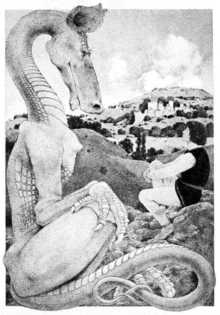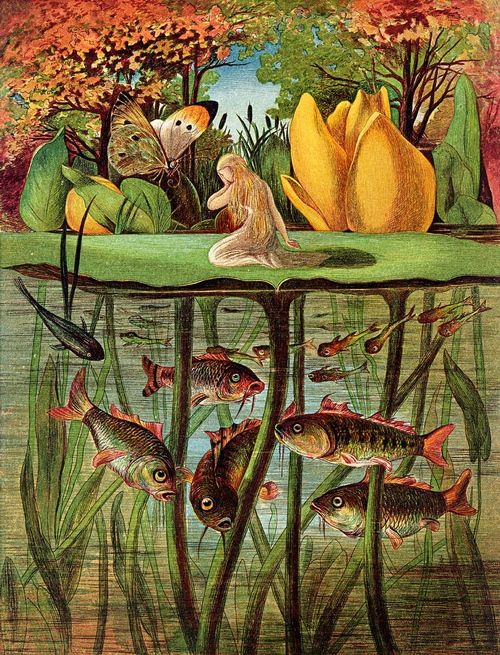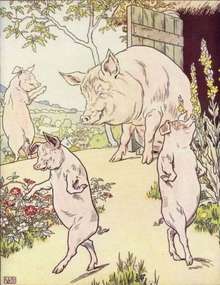Favorite Fairy Tales
We all love Fairy Tales! This guide offers recommended stories by age group, teaching ideas, discussion questions, and useful links. We hope it is particularly useful for students, teachers, and homeschool parents. You may also enjoy our complete collection of Children's Stories and Short Stories for Students
What are Fairy Tales?
Fairy Tales are stories involving fantastic forces, usually good versus evil, most originating in folklore, mythology, and legend. They feature fantasy beings like dragons, dwarfs, fairies and talking animals. They aren't just for kids. In fact, many are complex morality tales; some are graphic or morbid, and shouldn't be read to children at all. We recommend previewing stories before reading with your children.
Favorite Authors & Fairy Tales
- Hans Christian Andersen, The Ugly Duckling
- Brothers Grimm, Hansel and Gretel and Jack & the Beanstalk
- Aesop, The Grasshopper and the Ant
- Oscar Wilde, The Selfish Giant
- Joseph Kronheim, The Little Old Woman Who Lived in a Shoe
- Charles Perrault, Puss in Boots
- Peter Christen Asbjornsen, East of the Sun and West of the Moon
- Joseph Jacobs, The Tiger, the Brahman, and the Jackal
- Parker Fillmore, The Forest Bride
- Kenneth Grahame, The Wind in the Willows
- Nancy Bell & S.M. Mitra, A Clever Thief
- Frank Stockton, The Griffin and the Minor Canon
- Grace James, The Star Lovers
How are Fairy Tales different from Fantasy and Science Fiction?
Most Fairy Tales occur in the past, usually close to home. Some begin with "Once upon a time" and end with "and they lived happily ever after, THE END" but not always. They often feature magic or enchantments, but are unlike modern Fantasy, in which new worlds are created far from home (works by J.R.R. Tokien and C.S.Lewis). Fairy Tales tend to occur near home (Little Red Riding Hood was walking distance from her grandmother). They differ from Science Fiction, which usually occurs in the future and involves newfangled technologies, space and time travel (again, far from home). Folk Tales and Fables are types of Fairy Tales. A Folk Tale is a traditional story shared by a culture, passed on from one generation to the next. A Fable offers a moral lesson, usually involving animals and primarily geared towards children, such as Aesop's Fables. Some Fables are intended for older students and adults because they pose complex ethical questions, employ ironic twists, or are cautionary tales with elements of Gothic Horror. As you can tell, what we call "Fairy Tales" covers a lot of literary ground. They appeal to all ages and all cultures. Common characters and plots have been adapted in different countries, modernized for new generations, resulting in an ongoing shared global literacy.
Fairy Tales for Ages 4-7
- Goldilocks and the Three Bears featured in Short Stories for ChildrenA poor shoemaker and his wife are down to their last piece of leather when their fortunes change thanks to help from talented elves.
- Cinderella featured in Short Stories for ChildrenWill the prince find the pretty girl who dropped the little glass slipper?
- The Elves and the Shoemaker by The Brothers GrimmA poor shoemaker and his wife are down to their last piece of leather when their fortunes change thanks to help from talented elves.
- The Lion and the Mouse by Aesop"A kindness is never wasted."
- The Sagacious Monkey and the Boar featured in Children's StoriesThis Japanese Fable is about a clever monkey with a very clever plan.
- The Little Mermaid by Hans Christian AndersenThis lovely mermaid is willing to give up her fishtail and immortality in exchange for a human soul.
- The Three Billy-Goats Gruff featured in Short Stories for Children"Who's that tripping over my bridge?" roared the troll.
- My Father's Dragon by Ruth Stiles GannettEnjoy the magic of Elmer Elevator's adventures rescuing a baby dragon on Wild Island.
- How the Moon Became Beautiful featured in Children's StoriesThis Chinese Folk Tale explains why the moon is so bright and happy!
Fairy Tales for Ages 8-12
- The Last Dream of Old Oak by Hans Christian AndersenAn unlikely conversation between and old oak and a mayfly.
- The Reluctant Dragon by Kenneth Grahame"It's all right, father. Don't you worry. It's only a dragon."
- The Story of Aladdin featured in Arabian Nights"What wouldst thou have? I am ready to obey thee..."
- Androclus and the Lion by James BaldwinA poor slave named Androclus was not going to be like his cruel master.
- Huckleberry by Frank StocktonOld Riddler and Huckleberry are gnomes who teach humans through riddles.
- Hans the Hedgehog by The Brothers GrimmHans just doesn't fit in being a creature half-human, half-hedgehog.
- The Sprightly Tailor by Joseph JacobsA Celtic fairy tale about a tailor who makes a vest and pants for a giant.
Fairy Tales for Ages 13 - Adult
- The Little Match Girl by Hans Christian AndersenA poignant story about a girl homeless, cold and alone, but warmed by memories of her grandmother.
- The Selfish Giant by Oscar WildeWilde's fairy tale is an allegory, where a hidden meaning is revealed through the telling of the story, and reveals the author's spiritual journey.
- The Lady, or the Tiger? by Frank StocktonConfronted with an impossible choice, this story leaves the reader questioning which is better: free-will or determinism?
- The Travelling Companion by Hans Christian AndersenPoor John befriends a magical companion to help him negotiate a deadly courtship with an evil princess.
- The Gorgon's Head by Nathaniel HawthorneYoung Perseus sets out to secure the head of the Gorgon Medusa in order to win the Princess Hippodamia.
- Fantastic Fables by Ambrose BierceBierce applies his wit and cynicism in this collection of instructive allegories using the grotesquerie style. He is best known for his vivid Civil War stories such as An Occurrence at Owl Creek Bridge.
- A Clever Thief by Nancy Bell and S.M. MitraThis Hindu fairy tale from the Sanskrit asks, "Do you think there was anything good in the character of Hari-Sarman?"
Grown-ups might also enjoy Guy Wetmore Carryl's fairy tale and fable parody poems, and George Ade's Fables in Slang.
Favorite Quotes
"'How can I find a bride,” he asked himself, 'in a place where there are no human creatures at all!'" -- The Forest Bride: The Story of a Little Mouse Who Was a Princess
"Little pig! Little pig! Let me in! Let me in!' 'No! No! No! Not by the hairs on my chinny chin chin!" -- The Three Little Pigs
"Run, run, fast as you can. You can't catch me, I'm the Gingerbread man!" -- The Gingerbread Man
“Fee-fi-fo-fum, I smell the blood of an Englishman. Be he alive, or be he dead, I’ll grind his bones to make my bread!” -- Jack and the Beanstalk
"Mirror, mirror, on the wall, who is the fairest of us all?" -- Snow White
"'I have many beautiful flowers,' he said; 'but the children are the most beautiful flowers of all.'" -- The Selfish Giant
"No one had the slightest suspicion of what beautiful things she had seen; no one even dreamed of the splendor in which, with her grandmother she had entered on the joys of a new year." -- The Little Match Girl
Ideas for Teaching Fairy Tales
Differentiate these ideas for your grade level, and check our Useful Links for sample lesson plans.
- Select and read several stories (in class and encourage at-home online reading using our story links).
- Choose an engaging story for your grade level as a read-aloud (yes, even middle school teachers!)
- Identify elements of a traditional fairy tale (whole class)
- Venn diagram contrasting Fantasy, Fairy Tale, Gothic genres (HS/MS option)
- Use our Discussion Questions for small group discussion or as writing prompts
- Brainstorm a list of fairy tales everyone knows, try to identify a modern retelling of the same story. If you are stuck, consider Disney movies, or 12 Modern-Day Movies that are Fairy Tales in Disguise
Either assign a story or ask each student to select a specific story for a written assessment on the following:
- Point of view: who's telling the story, discuss how it might be different from another character's perspective.
- Are fairy tales always close to home?: Run through the list of all the stories the class has read (as a class and individually). How far away does the action occur from home [Does it confirm the assertion that Fairy Tales are usually close, Fantasy is far away?]
- Moral or take-away lesson: Identify the story's purpose, message, and audience (age level).
- "Fractured" Fairy Tales: compare The Three Little Pigs with The True Story of the 3 Little Pigs! by John Scieszka.
- Writers workshop: Have students pick a traditional fairy tale and write their own, either from an alternate perspective, or as a contemporary story (where iPhones and debates about global warming exist).
- Tweet about it: Write a series of tweets to tell the story, one tweet at a time.
- Optional video or in-class performance: Create media coverage, be a reporter "on the scene" of a familiar fairy tale, interview the characters to demonstrate different points of view.
Discussion Questions
1. Identify the characteristics of Fairy Tales, and how they differ from modern Fantasy and Science Fiction.
2. Fairy Tales are told in all cultures around the world, and passed from one generation to the next. Compare two Cinderella stories: Cinderella (German), with the Celtic version: Fair, Brown, and Trembling. Highlight their differences, and discuss the cultural distinctions in each story.
3. How have fairy tales changed over time? Take the scary Grimm's version of Little Snow-White for example, and compare it to the 2012 movie, Snow White and the Huntsman. Comment on the roles of special effects and graphic violence in the modern-day movie, compared to the graphic elements of hate and death in the story. Bonus: discuss the portrayal of the jealous Queen in Disney's 1937 Snow White movie.
4. Identify a scary fairy tale inappropriate for small children, with graphic violence, such as The Brothers Grimm's The Girl Without Hands or The Juniper-Tree. Re-write the story so it can be told to a 3 - 7 year old. What elements did you change?
5. Consider a modern creator of gothic fairy tales (Tim Burton or Stephen King). Provide examples of either author's works, and how they fit in the fairy tale genre.
6. Some fairy tales are not straight-forward "morality tales." They do not have clear "good" and "evil" elements, such as Frank Stockton's story that leaves you hanging, The Lady, or the Tiger? Discuss how its theme of determinism versus free will make this a "grown-up" allegory. [Visit our helpful The Lady, or the Tiger? Study Guide].
7. Pick a familiar fairy tale from the Children's Library, and write a gothic horror version of the story. [Use our Gothic Literature Study Guide for background on the genre.]
8. Read The Selfish Giant by Oscar Wilde, discuss its surface story, and its deeper meaning as a parable, in the kingdom of God, where the giant finds redemption by the Christ child. Here's a The Selfish Giant Study Guide to help you out.
9. Choose two of Ambrose Bierce's Fantastic Fables. Identify their "lessons" and ironic twist, featured in many of his tales. How do these seemingly absurd tales compare with his better-known Civil War Stories? Use our A Horseman in the Sky Study Guide for some ideas, then read that story.
10. Writing Prompt: Consider the epic Star Wars saga. Identify elements that are specific to each genre: Fairy Tale, Fantasy, Science Fiction, Fable, and Folk Tale (all these genres are present). Provide specific examples (and reference which episode) to demonstrate your understanding of the differences in genres. [Consult our Science Fiction Study Guide for helpful background.]
Useful Links
Fairy Tale Unit Lesson Plans (grades 6-8)
Fairy Tales form Life Lesson Plan (grades 3-5)
Fractured Fairy Tales Interactive Lesson (K-10th grade)
Writers Compare Modern Fantasy vs. Fairy Tales
Definitions of Fables, Fairy Tales, Myths and Legends
12 Modern-Day Movies that are Fairy Tales in Disguise
The Lady, or The Tiger? Study Guide
Notes/Teacher Comments
We need to hear from you! Please share your lesson plans, questions, or pitfalls to avoid while teaching this genre in pursuing our common interests of helping more students enjoy reading classic literature! Contact us via Facebook or Twitter
Visit our Teacher Resources, supporting literacy instruction across all grade levels




















